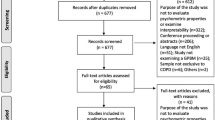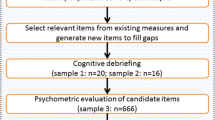Abstract
The purpose of this study was to estimate and compare preference scores derived from MOS Short Form-36 (SF-36) data for a sample of lung transplant patients using three methodologies: Fryback et al. (Med Decis Making 1997; 17: 1–9), Nichol et al. (Med Decis Making 2001; 21: 105–112) and Brazier et al. (J Health Econ 2002; 21: 271–292). Data were gathered from 99 lung transplant recipients using a mail survey, which included the SF-36 and other health-related quality of life (HRQL) measures. The mean preference score for the sample was 0.643 (range 0.43–0.83), 0.765 (range 0.36–1.0), and 0.697 (range 0.33–1.00) for Fryback, Nichol and Brazier methods, respectively. Correlations between the derived scores and visual analogue ratings of health (0.58–0.68) and pulmonary symptoms (−0.59 to −0.62) were moderate to good and in the expected directions. The mean preferences of patients grouped by levels of dyspnea, depression symptoms, illness burden, and self-rated general health differed significantly with all methods and supported the construct validity of the derived scores as measures of preference. The Nichol and Brazier scores, both derived with standard gamble utilities, were generally higher than Fryback scores, which are not utility-based. Given the popularity of the SF-36, these three methods could be useful where direct elicitation of preferences is not feasible. Researchers must be cognizant of the derivation method used, as absolute preference levels, hence quality adjusted life years (QALYs), will differ by method.
Similar content being viewed by others
References
Lenert L, Kaplan RM. Validity and interpretation of preference-based measures of health-related quality of life. Med Care 2000; 38(Suppl (II)): 138-150.
Torrance GW, Feeny D. Utilities and quality-adjusted life years. Int J Technol Assess Health Care 1999; 5: 559-575.
Kaplan RM, Bush JW, Berry CC. Health status: Types of validity and the index of well-being. Health Serv Res 1976; 11: 478-507.
Guyatt GH, Feeny DH, Patrick DL. Measuring health-related quality of life. Ann Int Med 1993; 118: 622-629.
Ware JE Jr, Sherbourne CD. The MOS 36-item short-form health survey (SF-36). 1. Conceptual framework and item selection. Med Care 1992; 30: 473-483.
McHorney GA, Ware JE, Raczek AE. The MOS 36-item short-form health survey (SF-36). II. Psychometric and clinical tests of validity in measuring physical and mental health constructs. Med Care 1993; 31: 247-263.
Brazier J, Usherwood T, Harper R, Thomas K. Deriving a preference-based single index from the UK SF-36 Health Survey. J Clin Epidemiol 1998; 51: 1115-1128.
McHorney GA, Ware JE, Raczek AE. The MOS 36-item short-form health survey (SF-36). III. Tests of data quality, assumptions and reliability across diverse patient groups. Med Care 1993; 31: 247-263.
Nerenz DR, Repasky DP, Whitehouse FW, Kahonen DM. Ongoing assessment of health status in patients with diabetes mellitus. Med Care 1992; 30: MS112-MS122.
Kurtin PS, Davies AR, Meyer KB, DeGiacomo JM, Kantz ME. Patient-based health status measures in outpatient dialysis. Med Care 1992; 30: MS136-MS149.
Brazier JE, Harper R, Jones NM, et al. Validating the SF-36 health survey questionnaire: New outcome measure for primary care. Br Med J 1992; 305: 160-164.
Vickrey BG, Mays RD, Graber J, et al. A health-related quality of life instrument for patients evaluated for epilepsy surgery. Med Care 1992; 30: 299-319.
O'Brien BJ, Buxton MJ, Ferguson BA. Measuring the effectiveness of heart transplant programmes: Quality of life data and their relationship to survival analysis. J Chronic Dis 1987; 40(Suppl 1): 137S-158S.
Feeny D. A utility approach to the assessment of health-related quality of life. Med Care 2000; 38: II151-II154.
Anonymous. Glossary. Pharmacoeconomics 1999; 16(2): 209.
Torrance GW. Measurement of health state utilities for economic appraisal. J Health Econ 1986; 5: 1-30.
Froberg DG, Kane RL. Methodology for measuring health-state preferences. II. Scaling methods. J Clin Epidemiol 1989; 42: 459-471.
Torrance GW, Thomas WH, Sackett DL. A utility maximization model for evaluation of health care programs. Health Serv Res 1972; 7: 118-133.
Pliskin JS, Shepard DS, Weinstein MC. Utility functions for life years and health status. Oper Res 1980; 28: 206-224.
von Neumann J, Morgernstern O. Theory of Games and Economic Behavior. New York, NY: John Wiley, 1953.
Keeny RL, Raiffa H. Decisions with Multiple Objectives: Preferences and Value Tradeoffs. New York, NY: Wiley, 1976.
Torrance GW, Feeny DH, Furlong WJ, Barr RD, Zhang Y, Wang Q. Multi-attribute utility function for a comprehensive health status classification system. Health Utilities Index Mark 2. Med Care 1996; 34: 702-722.
Kaplan RM, Anderson JP, Wu AW, Mathews WC, Kozin F, Orenstein D. The Quality of Well-being Scale. Applications in AIDS, cystic fibrosis, and arthritis. Med Care 1989; 27: S27-S43.
Kaplan RM, Anderson JP. A general health policy model: Update and applications. Health Serv Res 1988; 23: 203-235.
Kaplan RM, Patterson TL, Kerner DN, Atkinson JH, Heaton RK, Grant I. The Quality of Well-Being scale in asymptomatic HIV-infected patients. HNRC Group. HIV Neural Behavioral Research Center. Qual Life Res 1997; 6: 507-514.
Andresen EM, Rothenberg BM, Kaplan RM. Performance of a Self-Administered Mailed Version of the Quality of Well-Being (QWB-SA) Questionnaire Among Older Adults. Med Care 1998; 36: 1349-1360.
Feeny D, Furlong W, Boyle M, Torrance GW. Multi-attribute health status classification systems. Health Utilities Index. Pharmacoeconomics 1995; 7: 490-502.
Feeny DH, Torrance GW. Incorporating utility-based quality-of-life assessment measures in clinical trials. Two examples. Med Care 1989; 27: S190-S204.
Feeny D, Furlong W, Torrance George W, et al. Multi-attribute and single-attribute utility functions for the health utilities index mark 3 system. Med Care 2002; 40: 113-128.
Kind P, Dolan P, Gudex C, Williams A. Variations in population health status: Results from a United Kingdom national questionnaire survey. Br Med J 1998; 316: 736-741.
Hurst NP, Kind P, Ruta D, Hunter M, Stubbings A. Measuring health-related quality of life in rheumatoid arthritis: Validity, responsiveness and reliability of EuroQol (EQ-5D). Br J Rheumatol 1997; 36: 551-559.
Anonymous. EuroQol — a new facility for the measurement of health-related quality of life. The EuroQol Group. Health Policy 1990; 16: 199-208.
Fryback DG, Lawrence WF, Martin PA, Klein R, Klein BE. Predicting Quality of Well-being scores from the SF-36: Results from the Beaver Dam Health Outcomes Study. Medical Decision Making 1997; 17: 1-9.
Nichol MB, Sengupta N, Globe DR. Evaluating quality-adjusted life years: Estimation of the health utility index (HUI2) from the SF-36. Med Dec Mak 2001; 21: 105-112.
Brazier J, Roberts J, Deverill M. The estimation of a preference-based measure of health from the SF-36. J Health Econ 2002; 21: 271-292.
Radloff LS. The CES-D scale: A self-report depression scale for research in the general population. Appl Psychol Meas 1977; 3: 385-401.
Lough ME, Lindsey AM, Shinn JA, Stotts NA. Impact of symptom frequency and symptom distress on self-reported quality of life in heart transplant recipients. Heart Lung 1987; 16: 193-200.
Devins GM. Illness intrusiveness and the psychosocial impact of lifestyle disruptions in chronic life-threatening disease. Adv Renal Replace Ther 1994; 1: 251-263.
Matthees BJ, Anantachoti P, Kreitzer MJ, Savik K, Hertz MI, Gross CR. Use of complementary therapies, adherence, and quality of life in lung transplant recipients. Heart Lung 2001; 30: 258-268.
Gross CR, Malinchoc M, Kim RW, et al. Quality of life before and after liver transplantation for cholestatic liver disease. Hepatology 1999; 29: 356-364.
Green C, Brazier J, Deverill M. Valuing health-related quality of life. A review of health state valuation techniques. Pharmacoeconomics 2000; 17: 151-165.
Comstock GW, Tockman MS, Helsing KJ, Hennesy KM. Standardized respiratory questionnaires: Comparison of the old with the new. Am Rev Respir Dis 1979; 119: 45-53.
Bland M. An Introduction to Medical Statistics. Oxford: Oxford University Press, 1995; 270-272.
Bland MJ, Altman DG. Statistical methods for assessing agreement between two methods of clinical measurement. The Lancet 1986; 1: 307-310.
Colton T. Regression and Correlation. Statistics in Medicine. Little, Brown and Company, 1974: 189-218.
Ramsey SD, Patrick DL, Lewis S, Albert RK, Raghu G. Improvement in quality of life after lung transplantation: A preliminary study. J Heart Lung Transpl 1995; 14: 870-877.
Clarke AE, Goldstein MK, Michelson D, Garber AM, Lenert LA. The effect of assessment method and respondent population on utilities elicited for Gaucher disease. Qual Life Res 1997; 6: 169-184.
Bleichrodt H, Johannesson M. Standard gamble, time trade-off and rating scale: Experimental results on the ranking properties of QALYs. J Health Econ 1997; 16: 155-175.
Robinson A, Dolan P, Williams A. Valuing health status using VAS and TTO: What lies behind the numbers? Soc Sci Med 1997; 45: 1289-1297.
Hornberger J, Lenert LA. Variation among quality-of-life surveys. Theory and practice. Med Care 1996; 34: DS23-DS33.
Torrance GW. Toward a utility theory foundation for health status index models. Health Serv Res 1976; 11: 349-369.
Gold M, Siegel JE, Russell LB, Weinstein MC. Cost-effectiveness in Health and Medicine. New York: Oxford University Press, 1996.
Russell LB, Gold MR, Siegel JE, et al. The role of cost-effectiveness analysis in health and medicine. JAMA 1996; 276: 1172-1177.
Torrance GW. Utility approach to measuring health-related quality of life. J Chronic Dis 1987; 40: 593-603.
Voruganti LN, Awad AG, Oyewumi LK, Cortese L, Zirul S, Dhawan R. Assessing health utilities in schizophrenia. A feasibility study. Pharmacoeconomics 2000; 17: 273-286.
Anderson JP, Kaplan RM, Coons SJ, Schneiderman LJ. Comparison of the Quality of Well-being Scale and the SF-36 results among two samples of ill adults: AIDS and other illnesses. J Clin Epidemiol 1998; 51: 755-762.
Author information
Authors and Affiliations
Rights and permissions
About this article
Cite this article
Lobo, F.S., Gross, C.R. & Matthees, B.J. Estimation and comparison of derived preference scores from the SF-36 in lung transplant patients. Qual Life Res 13, 377–388 (2004). https://doi.org/10.1023/B:QURE.0000018488.95206.d6
Issue Date:
DOI: https://doi.org/10.1023/B:QURE.0000018488.95206.d6




